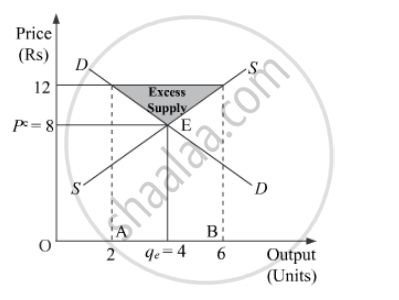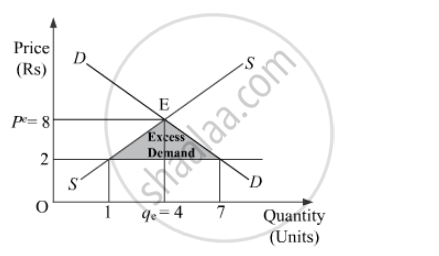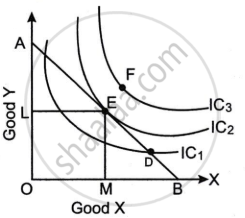Advertisements
Advertisements
Question
Market for a good is in equilibrium. Explain the chain of reactions in the market if the price is (i) higher than equilibrium price and (ii) lower than equilibrium price.
Solution
(i) When the market price is higher than the equilibrium price then it results in a situation of excess supply. That is, under such a situation the market demand falls short of the market supply.

In the diagram, the initial equilibrium is established at point E, where the market demand curve and the market supply curve intersect. Correspondingly, the equilibrium price is OPe at Rs 8 and the equilibrium quantity is Oqe at 4 units.
Let price rise above the equilibrium price to Rs 12. At this price, the market demand is 2 units, whereas the market supply is 6 units. As the market supply exceeds the market demand, so there exists excess supply of 4 units (6 - 2). As a result of this excess supply, the competition among the sellers to sell their output increases and they are ready to reduce the price in order to sell more units of output. The fall in the price continues until it becomes equal to OPe, where the market demand equals the market supply.
(ii) On the other hand, when the market price is lower than the equilibrium price then it results in a situation of excess demand. Excess demand refers to a situation where market demand exceeds market supply at a particular market price.

In the diagram, the initial equilibrium is established at point E, where the market demand curve and the market supply curve intersect. Correspondingly, the equilibrium price is OPe at Rs 8 and the equilibrium quantity is Oqe at 4 units.
Let the market price be below the equilibrium price, say Rs 2. At this price, the market demand equal to 7 units and the market supply is 1 unit. Thus, there exists excess demand as the market demand exceeds the market supply. As a result, the competition among the buyers to purchase the output rises and they are ready to pay higher prices for the output. The rise in the market price continues until it reaches the equilibrium price OPe, where the market demand equals the market supply.
APPEARS IN
RELATED QUESTIONS
A Consumer consumes only two goods X and Y. Marginal utilities of X and Y is 4 and 5 respectively. The prices of X and Y are Rs 4 per unit and Rs 5 per unit respectively. Is the consumer in equilibrium? What will be the further reaction of the consumer? Explain.
A consumer consumes only two goods A and B and is in equilibrium. Show that when price of good B falls, demand for B rises. Answer this question with the help of utility analysis
Given the price of a good, how does a consumer decide as to how much of the good to buy?
A consumer consumes only two goods X and Y. If marginal utilities of X and Y are 4 and 5 respectively, and if price of X is Rs 5 per unit and that of Y is Rs 4 per unit is the consumer in equilibrium? What will be further reaction of the consumer? Explain.
A consumer consumes only two goods X and Y both priced at Rs 3 per unit. If the consumer chooses a combination of these two goods with Marginal Rate of Substitution equal to 3, is the consumer in equilibrium? Give reasons. What will a rational consumer do in this situation? Explain
A consumer consumes only two goods X and Y whose prices are Rs 4 and Rs 5 per unit respectively. If the consumer chooses a combination of the two goods with marginal utility of X equal to 5 and that of Y equal to 4, is the consumer in equilibrium? Give reason. What will a rational consumer do in this situation? Use utility analysis.
A consumer consumes only two goods X and Y whose prices are Rs 5 and Rs 4 respectively. If the consumer chooses a combination of the two goods with marginal utility of X equal to 4 and that of Y equal to 5, is the consumer in equilibrium? Why or why not? What will a rational consumer do in this situation? Use utility analysis
Market for a good is in equilibrium. There is simultaneous “decrease” both in demand and supply but there is no change in market price. Explain with the help of a schedule how it is possible.
How does the equilibrium price of a ‘normal’ commodity change when income of its buyers falls? Explain the chain effects.
What are the conditions of consumer’s equilibrium under the indifference curve approach? What changes will take place if the conditions are not fulfilled to reach equilibrium?
From the following schedule find out the level of output at which the producer is in equilibrium, using marginal cost and marginal revenue approach. Give reasons for your answer.
|
Price per unit (Rs) |
Output (Units) |
Total Cost (Rs) |
|
8 |
1 |
6 |
|
7 |
2 |
11 |
|
6 |
3 |
15 |
|
5 |
4 |
18 |
|
4 |
5 |
23 |
Equilibrium price falls and equilibrium quantity rises when ______
Identify the correctly matched pair from Column A to that of Column B:
| Column A | Column B | ||
| (1) | Investment Multiplier | (a) | C + I + G + (X − M) |
| (2) | Marginal Propensity to Consume | (b) | `(ΔC)/(ΔY)` |
| (3) | Marginal Propensity to Save | (c) | `(ΔI)/(ΔY)` |
| (4) | Aggregate Demand | (d) | `(ΔS)/(ΔY)` |
With the help of a diagram, explain how the consumer will attain equilibrium on the consumption of a single commodity at a given price.
Refer to the diagram given below and answer the questions that follow.

- What does the line AB represent? Why is the line AB negatively sloped? (2)
- At which one of the given points, D, E and F, will the consumer attain equilibrium? Explain. (2)
- Briefly explain why the consumer is not in equilibrium at the other two points. (2)
